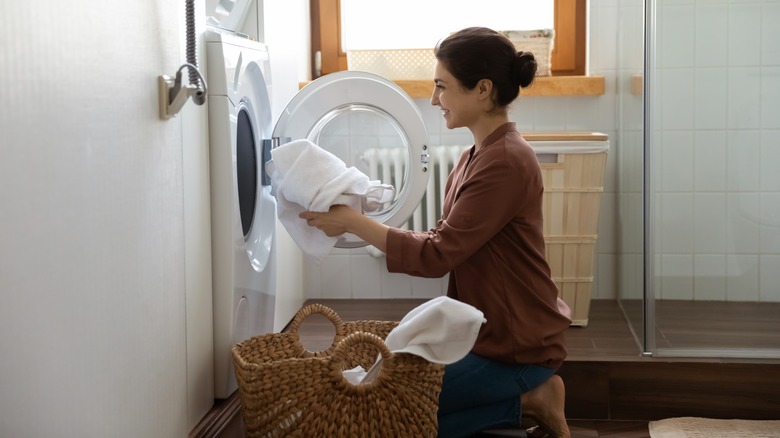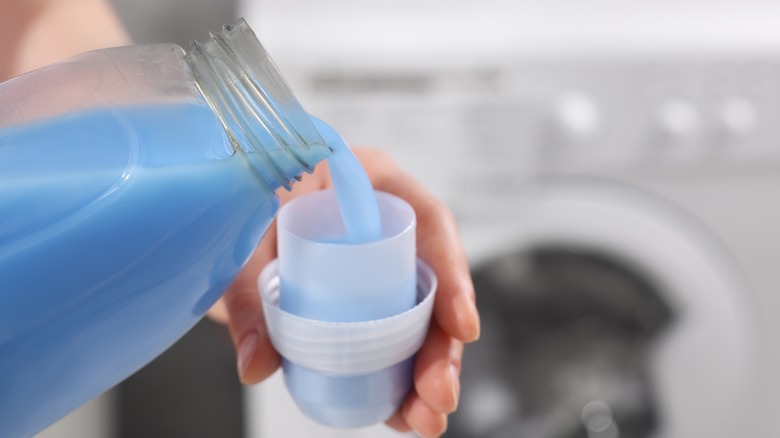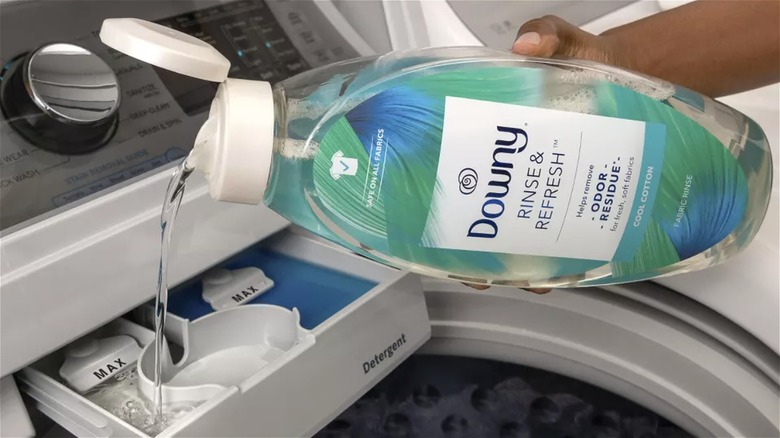How Fabric Rinses Differ From Other Laundry Products (And When To Use Them)
We may receive a commission on purchases made from links.
Because there are so many laundry products on the market, it can be difficult to determine exactly what part of the laundry process each should be used for and which items are truly necessary. From fabric softeners to scent-boosting beads, it seems like the long list of products recommended to make laundry stay fresh longer is never-ending. While some of these products are simply used to add fragrance, others are more useful in maintaining the quality and cleanliness of your clothing, including a fabric rinse. This liquid product goes into the fabric softener section of your washing machine and breaks down build-up that prevents your clothes from being washed properly or smelling great. Therefore, this product is ideal to use if your clothes feel stiff, have lingering odors, or just need a refresh.
To use a fabric rinse, pour it into the fabric softener section of your washer's detergent drawer as the final step after adding your dirty laundry and detergent. As for the amount you should use, fill a little less than half of your fabric softener section for small loads. For large loads, you should fill the fabric softener section to the maximum fill line. After pouring in the appropriate amount of fabric rinse, simply wash and dry your clothes as usual. Once fully dry, you should notice that any residue or odors are gone.
How fabric rinses differ from scent boosters and other products
You might be wondering how fabric rinses differ from products like scent boosters. Unlike scent boosters that just add a fresh scent, fabric rinses actually break down and remove residue. This residue can lead to odor over time because it prevents water and laundry detergent from being able to penetrate fabric fibers properly. Even laundry detergent itself can contribute to the build-up of this residue. This is especially true for those who use more laundry detergent than they actually need per load. It can make clothes stiff and lock in odors over time. Fabric rinses help remove this excess detergent to get laundry soft and fresh again.
Fabric rinses are also very different from traditional fabric softeners or conditioners. Fabric softeners typically only lubricate the fibers in your clothes so that they are not stiff and uncomfortable after the washing and drying process. Meanwhile, fabric rinses eliminate the residue that builds up on clothes over time and leads to hard-to-remove smells. If you have attempted to use either fabric softeners or scent boosters to remove lingering odors or build-up with no success, this may be the reason why. Neither of these products were designed to solve that problem. You should use fabric rinses whenever you are dealing with stubborn odor or residue build-up on your clothes.
Things to keep in mind before using fabric rinses
By now, you might be persuaded to make fabric rinses a part of your family's laundry routine. However, before incorporating the product into your next load of laundry, you should know that it cannot be mixed with bleach or fabric softener. In fact, it shouldn't be mixed with anything in the fabric softener section of your washing machine. If you need to use bleach or fabric softener on your clothes, you will have to add those products to your washer in a separate load.
Fabric rinses can, however, be used with items like scent beads that go directly in the drum. Additionally, unlike some laundry products, fabric rinses can be used on any material that is machine washable. From bedding to activewear, you can enjoy the benefits of the product's odor-eliminating power on anything you normally wash in your machine without having to worry about damaging your fabrics.
There are a few different fabric rinses available to purchase online and in-store. Downy Rinse and Refresh and Tide Clean Boost Fabric Rinse are some of the more well-known options. These can be purchased at stores like Walmart, Target, Amazon, and other retailers. They typically range anywhere from $7 to $13 depending on which brand you purchase and the size of the bottle.


